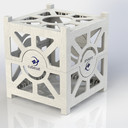
Thanks to everyone who participated! There were so many unique solutions for this tough, mechanical challenge. To pick the winners, the judges took an in-depth look at how each finalist stacked up in terms of the judging criteria, and rated them from 1 to 10 in each category (10 being criteria fulfilled, 1 being unfulfilled). Congratulations to the winners!
What a response! We had many more entrants than we expected, and were delighted to see the variety and fidelity of the designs submitted.
Thank you to all the designers for sharing your creativity and technical insight. There are far more top-notch designs than the ten our judges were able to select, and the competition was incredibly close. Thank you also to our all-star judging panel for your careful scrutiny and discerning critique.
From this challenge, we had the opportunity to learn a number of things. First, the response rate shows the interest level in Additive Manufacturing (AM), CubeSats, and the potential future they share. Second, we had the opportunity to see how familiar designers are with AM. Clearly, a number of you have explored the technology deeply and understand many of the things you can and can’t do with the various technologies – FDM, SLS, and DMLS. What’s even more interesting, personally, is seeing what didn’t feature heavily in the submissions, as those are the features and benefits of the technology that we need to continue to share and emphasize. Integrating metal components in plastic, embedded electronics, and functional composite materials all appeared minimally or not at all, and these may be some of the ways we can take AM CubeSat design even further beyond the phenomenal entries we’ve seen this summer.
We encourage you to continue to think about and experiment with CubeSat designs. As the small satellite industry appears to be on the edge of dramatic expansion, We are confident that your innovation and design skills will be highly sought after. We are also confident that AM will be a significant part of the next wave of small satellite development, as complex, light weight, multi-functional structures will be key to lowering cost and packing the maximum utility into the smallest volume and weight.

FoldSat is an elegant design that leverages geometries only available with 3D printing. Paolo takes the concept even further by illustrating how the design also implements DFAM (design for additive manufacturing) best practices. FoldSat also gets a bonus for incorporating all the common CubeSat features, including PCB mounting slots and features for easy maintenance. Great job!
Adhere to Technical Requirements: 10
Technical Feasibility: 9
Producibility: 9
Value: 8
Optimal for Additive Manufacturing: 9

A comprehensive and polished entry that directly addresses the technical requirements and judging criteria. #David also elaborates on customization, showing several concepts that use real cubesat components. Nice knock-out panel concept for rapid customization from a standardized component.
Adhere to Technical Requirements: 10
Technical Feasibility: 8
Producibility: 8
Value: 9
Optimal for Additive Manufacturing: 8

Very cool concept where multiples could easily be 3D printed at the same time, by optimizing build volume layout. It features 3D printed threads, 6 hinged panels and has a detailed analysis of manufacturing processes, materials, and cost. It does lack incorporation of some common cubesat features, though this was not a core requirement of the challenge.
Adhere to Technical Requirements: 10
Technical Feasibility: 9
Producibility: 9
Value: 7
Optimal for Additive Manufacturing: 8

This entry offers a great evaluation using FDM tools!
Adhere to Technical Requirements: 10
Technical Feasibility: 9
Producibility: 9
Value: 7
Optimal for Additive Manufacturing: 7

The Kube is simple, meets the requirements, and makes great use of 3D printing technologies.
Adhere to Technical Requirements: 10
Technical Feasibility: 9
Producibility: 9
Value: 7
Optimal for Additive Manufacturing: 7

Simple assembly method & lightweighting of structure. Bonus points for using 3D printed trusses.
Adhere to Technical Requirements: 10
Technical Feasibility: 8
Producibility: 7
Value: 8
Optimal for Additive Manufacturing: 8

Great idea! This design uses 3d printing to make snap-together pcb holders that double as the cubesat frame. It may be better suited for injection molding however.
Adhere to Technical Requirements: 10
Technical Feasibility: 7
Producibility: 8
Value: 8
Optimal for Additive Manufacturing: 7

This entry has a great modular design that toward 3U, 6U, and 12U.
Adhere to Technical Requirements: 10
Technical Feasibility: 8
Producibility: 8
Value: 7
Optimal for Additive Manufacturing: 7

This design makes great use of organic structure for optimization!
Adhere to Technical Requirements: 10
Technical Feasibility: 8
Producibility: 7
Value: 8
Optimal for Additive Manufacturing: 7

Simple design approach that ignores design for *subtractive* manufacturing to optimize frame geometry (irony is that end product is likely manufacturable by subtractive methods).
Adhere to Technical Requirements: 10
Technical Feasibility: 8
Producibility: 7
Value: 7
Optimal for Additive Manufacturing: 6














If you don't receive the email within an hour (and you've checked your Spam folder), email us as confirmation@grabcad.com.